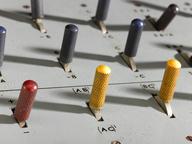







One of four original Swan and Raven models used by William froude on River Dart in 1867 measuring 6 foot in length.
Swan and Raven are experimental hull shapes constructed by William Froude to investigate the drag of ships when moving through water. This determines how much power and fuel a vessel needs for a given speed. His work marked a major step in nineteenth century engineering science.
Froude tested these hulls on the River Dart, near Dartmouth, towing them by steam launch and recording the speed and the pull on the towing cable. His main aim was to establish how model results could be scaled up to predict full-size performance. Many previous experimenters had failed to do this. Froude built these hull pairs in three sizes – three feet, six feet and twelve feet.
By comparing the results over the three sizes Froude was able to establish the mathematical law that related scale-model results to full-size performance. Known as a ‘similarity law’, this became an important design tool and also anticipated an analogous approach applied later to interpret the wind tunnel testing of aircraft model shapes.
Details
- Category:
- Froude
- Object Number:
- 1941-4/1
- Measurements:
-
Overall: 830 mm x 1830 mm x 300 mm, 100 kg
- type:
- study models, hydrodynamics and hydrodynamic resistance
- credit:
- Admiralty



